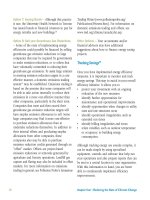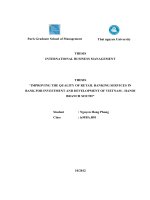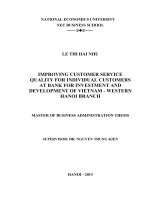Improving credit quality for small and medium sized enterprises at joint stock commercial bank for investment and development of vietnam transaction office 1
Bạn đang xem bản rút gọn của tài liệu. Xem và tải ngay bản đầy đủ của tài liệu tại đây (1.41 MB, 97 trang )
ĐẠI HỌC QUỐC GIA HÀ NỘI
KHOA QUẢN TRỊ VÀ KINH DOANH
---------------------
LÊ VĂN ĐỨC
IMPROVING CREDIT QUALITY FOR SMALL AND MEDIUMSIZED ENTERPRISES AT JOINT STOCK COMMERCIAL BANK
FOR INVESTMENT AND DEVELOPMENT OF VIETNAM TRANSACTION OFFICE 1
NÂNG CAO CHẤT LƯỢNG TÍN DỤNG ĐỐI VỚI DOANH NGHIỆP
NHỎ VÀ VỪA TẠI NGÂN HÀNG TMCP ĐẦU TƯ VÀ PHÁT TRIỂN
VIỆT NAM – CHI NHÁNH SỞ GIAO DỊCH 1
LUẬN VĂN THẠC SĨ QUẢN TRỊ KINH DOANH
HÀ NỘI - 2018
ĐẠI HỌC QUỐC GIA HÀ NỘI
KHOA QUẢN TRỊ VÀ KINH DOANH
---------------------
LÊ VĂN ĐỨC
IMPROVING CREDIT QUALITY FOR SMALL AND MEDIUMSIZED ENTERPRISES AT JOINT STOCK COMMERCIAL BANK
FOR INVESTMENT AND DEVELOPMENT OF VIETNAM TRANSACTION OFFICE 1
NÂNG CAO CHẤT LƯỢNG TÍN DỤNG ĐỐI VỚI DOANH NGHIỆP
NHỎ VÀ VỪA TẠI NGÂN HÀNG TMCP ĐẦU TƯ VÀ PHÁT TRIỂN
VIỆT NAM – CHI NHÁNH SỞ GIAO DỊCH 1
Chuyên ngành: Quản trị kinh doanh
Mã số: 60 34 01 02
LUẬN VĂN THẠC SĨ QUẢN TRỊ KINH DOANH
NGƯỜI HƯỚNG DẪN KHOA HỌC: TS. PHẠM VĂN HỒNG
Hà Nội - 2018
DECLARATION
“I would like to undertake the whole thesis "Improving credit quality for small
and medium enterprises at Vietnam Development Bank - Transaction Office 1" is
my own independent work. All analyzes in the subject matter have a clear origin.
All references in this article are subject to current regulations of the Faculty of
Business Administration - Hanoi National University.
Ha Noi, 16/01/2018
ACKNOWLEDGEMENT
“This thesis is completed with many valuable help. First of all, I would like to
send my sincere thanks to Pham Van Hong, facilitator, facilitated, enthusiastic,
responsible with me during the thesis, I also appreciate the teachers in the Faculty of
Management Business - National University of Hanoi; The scientists, authors of
scientific papers, articles I consulted helped me complete this thesis.
Honor to thank!
TABLE OF CONTENTS
ABBREVIATIONS ....................................................................................................i
FIGURE .................................................................................................................... ii
TABLE ..................................................................................................................... iii
INTRODUCTION .....................................................................................................1
Chapter 1: THEORETICAL FRAMEWORK ON CREDIT QUALITY FOR
SMEs AT COMMERCIAL BANKS .......................................................................6
1.1 Small and medium-sized enterprises ............................................................6
1.1.1 Concept ......................................................................................................6
1.1.2 Characteristics of SMEs ............................................................................7
1.1.3 Role of SMEs in the economy ....................................................................8
1.2 Bank credit for SMEs ...................................................................................10
1.2.1 Concept of bank credit ............................................................................10
1.2.2 Characteristics and role of bank credit for SMEs ...................................11
1.2.3 Bank credit products for SMEs ...............................................................11
1.3 Quality of credit for SMEs ...........................................................................13
1.3.1 Concept ....................................................................................................13
1.3.2 Necessity of improving credit quality for SMEs ......................................14
1.3.3 Indicators for assessing credit quality for SMEs ....................................15
1.3.4 Factors affecting the improvement of credit quality for SMEs at
commercial banks .............................................................................................19
1.3.5 Experience in improving credit quality for SMEs at some commercial
banks .................................................................................................................22
Chapter 2: REALITY OF CREDIT QUALITY FOR SMEs AT BIDV –
TRANSACTION OFFICE 1 ..................................................................................27
2.1. Overview of BIDV- Transaction Office 1 ..................................................27
2.1.1 History of foundation and development of BIDV- Transaction Office 1 27
2.1.2 General functions and duties of BIDV – Transaction Office 1 ...............29
2.1.3 Organizational structure .........................................................................29
2.1.4. Business operations of BIDV – Transaction Office 1 in recent years....33
2.2 Reality of credit quality for SMEs at BIDV – Transaction Office 1 ........39
2.2.1. Overview of SME customers at BIDV – Transaction Office 1 ...............39
2.2.2 Indicators of credit quality for SMEs at BIDV – Transaction Office 1 ..40
2.3. Evaluation of reality of credit quality for SMEs at BIDV – Transaction
Office 1 ..................................................................................................................58
2.3.1 Achievements ...........................................................................................58
2.3.2 Limitations and causes of the limitations ................................................58
Chapter 3: SOLUTIONS TO IMPROVE CREDIR QUALITY FOR SMEs AT
BIDV – TRANSACTION OFFICE 1 ....................................................................71
3.1 Some orientations for developing credit activities for SMEs at BIDV –
Transaction Office 1 ...........................................................................................71
3.2 Solutions to improve credit quality for SMEs at BIDV – Transaction
Office 1 .................................................................................................................72
3.2.1 Develop a suitable credit policy ..............................................................72
3.2.2 Complete the collection and processing of information..........................73
3.2.3 Enhance the quality of credit staff ...........................................................76
3.2.4 Increase the inspection and control activities .........................................78
3.2.5 Strengthen advisory service.....................................................................80
3.3 Recommendations .........................................................................................80
3.3.1 For the Government ...............................................................................80
3.3.2 For the State bank ..................................................................................81
3.3.2 For Head Office BIDV ...........................................................................81
CONCLUSION ........................................................................................................83
REFERENCES ........................................................................................................84
ABBREVIATIONS
NO.
ABBREVIATIONS FULL FORMS
1
BIDV
2
SMEs
Joint Stock Commercial Bank for Investment and
Development of Vietnam
Small and medium-sized enterprises
i
FIGURE
Figure 2.1: Organizational structure of BIDV – Transaction Office 1 .....................32
Figure 2.2: Procedure of granting credit at BIDV – Transaction Office 1 ...............67
Figure 3.1: Sources of information in credit appraisal and approval .......................75
ii
TABLE
Table 1.1: Criteria for categorizing SMEs in accordance with Decree No.
56/2009/NĐCP ............................................................................................................7
Table 2.1: Scale of credit growth at BIDV – Transaction Office 1 over the years ...33
Table 2.2: Scale of capital mobilization at BIDV – Transaction Office 1 over the
years ..........................................................................................................................35
Table 2.3: Indicators of general operations of BIDV – Transaction Office 1 over the
years ..........................................................................................................................37
Table 2.4: Income structure from operation segments at BIDB – Transaction Office
1 .................................................................................................................................37
Table 2.5: Revenue from services of BIDV – Transaction Office 1 .........................39
Table 2.6: Development of new SME customers at BIDV – Transaction Office 1 ..41
Table 2.7: Scale of developing SME customers in Hanoi area of BIDV –
Transaction Office 1 ..................................................................................................41
Table 2.8: Credit growth at BIDV - Transaction Office 1 ........................................42
Table 2.9: Credit structure by sector for SMEs at BIDV – Transaction Office 1 .....44
Table 2.10: Credit structure by products and services provided by the bank ...........45
Table 2.11: Situation of using preferential credit packages to develop credit for
SMEs at BIDV – Transaction Office 1 .....................................................................48
Table 2.12: Overdue loans and bad loans over total outstanding loans for SMEs ...50
Table 2.13: Situation of off-balance-sheet debt recovery for SMEs banks at BIDV –
Transaction Office 1 ..................................................................................................52
Table 2.14: Overdue loans and bad loans by groups of sectors ................................53
Table 2.15: Credit turnover for SMEs at the branch .................................................55
Table 2.16: Profits from credit activities ...................................................................56
Table 2.17: Cases of credit limitation and credit refusal at the branch .....................57
Table 2.18: Some documents to reduce credit risks at BIDV Transaction Office 1 59
Table 2.19: Survey on the credit policy of the branch ..............................................60
iii
Table 2.20: Lending interest rates for SMEs at BIDV – Transaction Office 1.........61
Table 2.21: Information about human resources in a typical credit department .......62
Table 2.22: Survey on human resources of the branch .............................................63
Table 2.23: Survey on the ability to collect and process information of the branch 64
Table 2.24: Survey on the control process of the branch ..........................................65
Table 2.25: Survey on the credit procedures of the branch.......................................68
iv
INTRODUCTION
1. Rationale of the study
In the process of economic development, small and medium-sized enterprises
(SMEs) play a very important role in the economy of a country, especially a
developing country like Vietnam where SMEs account for over 90% of the total
number of enterprises. Every year, these enterprises contribute 50% of GDP and
generate 62% of employment. Therefore, the Government of Vietnam has a lot of
preferential policies for SMEs to promote this economic component to develop,
improve business efficiency and competitiveness in the domestic as well as
international market and encourage commercial banks to take different measures to
finance credit for SMEs.
In operations of banks, credit activities are one of the main sources of profit
(accounting for 70-80% of the bank's profit). Therefore, developing credit activities
has always been one of the current development trends of Vietnamese commercial
banks.
Based on this fact, commercial banks in Vietnam in general and Joint Stock
Commercial Bank for Investment and Development of Vietnam (BIDV) in particular
are very interested in credit activities for SMEs. Over many years of innovation, the
credit activities for SMEs of commercial banks in Vietnam have generally achieved
encouraging results in terms of both scale and quality of services. Being the largest
branch operating in BIDV system - one of the credit institutions assessed as having
strong credit activities for SMEs in Vietnam in recent years - BIDV - Transaction
Office 1, in addition to its successes, still has certain limitations in credit activities for
SMEs such as low credit quality and large potential risks.
This situation requires the bank to take reasonable and sound management
measures in credit activities for SMEs since these activities bring a great profit to the
bank and help diversify the target customer groups, but are potentially risky. Over the
years, BIDV – Transaction Office 1 has implemented a number of measures to
increase credit for small and medium-sized enterprise customers and reduce possible
1
risks through screening customers, accelerating appraisal before and after lending, etc.
However, the ratios of bad loans and overdue loans of the bank are still high, which
has bad impact on the credit quality of the branch. Starting from the reasons above, the
study of solutions to improve the quality of credit for SMEs at commercial banks in
the country is practical and urgent.
Therefore, the topic "Improving credit quality for small and medium-sized
enterprises at Joint Stock Commercial Bank for Investment and Development of
Vietnam - Transaction Office 1" was chosen as the research topic for this thesis.
2. Research overview
In our country, although there have been quite a lot of studies on credit quality
improvement to expand the scale of commercial banks, each author conducted
research in a context suitable for each commercial bank. Due to the different
characteristics and specialization of the banks, their results could not be stereotyped to
the model of the commercial bank system.
There have been many studies on credit and credit quality for SMEs at different
levels in Vietnam, namely:
The study by Le Hai Nhung (2014) on "Credit quality for small and mediumsized enterprises at Asia Commercial Bank - Hanoi Branch": The author carried out
the research with the aim to clarify the shortcomings in the issue of credit quality for
SMEs at Asia Commercial Bank - Hanoi Branch to propose solutions to improve the
quality of the credit activities. With this purpose, the author presented basic issues of
credit quality in general and credit quality for SMEs in particular. Based on that, the
author evaluated the credit quality at Asia Commercial Bank - Hanoi Branch and
showed the advantages and limitations as well as the causes in the credit activities.
Thereby, the measures to improve credit quality for SMEs at Asia Commercial Bank Hanoi Branch were proposed. However, in this study, the author had not analyzed the
factors affecting the credit quality for SMEs at Asia Commercial Bank as the basis for
proposing appropriate solutions.
The study by G. Vairava Subramanian and S. Nehru (2012) on Implementation
of credit rating for SMEs (Small & Medium Enterprises) – How is beneficial to Indian
2
SMEs: According to the author, SMEs are contributing more than 16-18% to India's
GDP. If they received more support, SMEs would contribute more than 30% to the
GDP. The biggest challenge for SMEs in India was the efficient management of
finance both for the operation of the organization and for the business expansion. The
author conducted the research with the aim to help enterprises in India easily access to
credit and set up the credit rating plan and process. In the study, the author presented
the following topics: concept of credit rating, mechanism for credit rating, planning of
credit rating, process of credit rating and benefits of credit rating for small and
medium enterprises. However, since the author only used qualitative methods and
secondary data without using expert method to collect primary data, the results of the
research did not ensure the objectiveness.
In the study "Expanding and improving access to credit for small and mediumsized enterprises" by the Central Institute for Economic Management (2009), the
authors pointed out that the shortage in capital and the difficulty in accessing capital
are one of the biggest obstacles in the development of small and medium-sized
enterprises in Vietnam nowadays. According to this study, the lack of capital and the
difficulty in accessing capital of SMEs come from both sides: the enterprises
themselves and the commercial banking system. However, this study only focused on
the barriers for SMEs in accessing credit without referring to the assessment of credit
quality at commercial banks, as a basis for enterprises to access to credit.
The research by Vo Duc Toan (2012) on "Credit for SMEs of Joint Stock
Commercial Banks in HCM City": The study focused on the reality of credit quality
for SMEs and proposed solutions to expand and improve credit quality of Joint Stock
Commercial Banks for SMEs in Ho Chi Minh City. The study surveyed SMEs and
Joint Stock Commercial Banks which are related to bank credit for SMEs. However,
the research mainly focused on the analysis and assessment of SMEs but had not
focused on analyzing and evaluating the banks’ activities for SMEs and evaluating the
credit quality of SMEs. As a result, the research did not provide specific solutions to
solve the problems of bank credit quality.
3
The study of Truong Quang Thong (2010) entitled "Bank credit financing for
SMEs - An empirical study in Ho Chi Minh City": This study surveyed and assessed
the reality of operations of SMEs in Ho Chi Minh City, and suggested policies to
support the development of this enterprise system in Ho Chi Minh City through the
policy of credit financing access from commercial banks. However, the author only
focused on the credit financing policies of commercial banks without studying the
factors affecting the quality of credit as a precondition for proposing policies.
So far, the author has not found a comprehensive study on the quality of credit
for SMEs in the system of commercial banks in Vietnam, especially at BIDV –
Transaction Office 1. Therefore, this topic will have different points from previous
studies and promise to fill the gap of the previous researches.
3. Research objectives
3.1 General objective
This study aims at researching and assessing the quality of credit for SMEs at
BIDV - Transaction Office 1 to find out limitations and propose solutions and
recommendations to improve the quality of credit for SMEs at the bank.
3.2 Specific objectives
- Systematize the theoretical framework on SMEs and credit quality for SMEs at
commercial banks; determine the need to improve the credit quality as well as factors
affecting credit activities at commercial banks.
- Analyze and assess of the credit quality for SMEs at BIDV – Transaction
Office 1 through the results of lending activities to SMEs at the bank and criteria for
assessing credit quality BIDV - Transaction Office 1 in the period of 2013 - 2016.
- Proposed a group of solutions to improve the credit quality for SMEs at BIDV –
Transaction Office 1.
4. Research object
The study concentrated on studying the quality of credit for small and mediumsized enterprises at BIDV – Transaction Office 1.
5. Research scope
4
Due to the time constraints, the data (including internal documents of the bank
and other related materials) used in the thesis were collected from 2013 to 2016.
6. Research methods
6.1 Data collection method
To accomplish the research goal, the author collected both secondary data and
primary data.
Secondary data consisted of information related to the bank's credit operations,
information on credit assessment and factors affecting the bank's credit quality.
Primary information was collected by measuring staff’s assessment towards the
bank's lending activities to SMEs in the form of a survey.
6.2 Data analysis method
After being collected, the data were synthesized by Excel software and
analyzed in the form of tables and charts. The analysis results were used to assess the
credit quality at the bank.
6.3 Expert interview method
The author conducted interviews with managers of corporate credit at BIDV Transaction Office 1 to synthesize the factors affecting the credit quality at the branch.
7. Organization of the thesis
The thesis consists of three chapters:
Chapter 1: Theoretical background of credit quality for SMEs at commercial
banks.
Chapter 2: Reality of credit quality for SMEs at BIDV - Transaction Office 1.
Chapter 3: Solutions to improve credit quality for SMEs at BIDV - Transaction
Office 1.
5
Chapter 1: THEORETICAL FRAMEWORK ON CREDIT QUALITY FOR
SMEs AT COMMERCIAL BANKS
1.1 Small and medium-sized enterprises
1.1.1 Concept
According to the Law on Enterprises of 2005, an enterprise is an economic
organization which has its own name, own property and a stable office registered for
business in accordance with the law for the purpose of conducting business activities.
The types of enterprises in the market economy are diversified and abundant, in
which enterprises categorized based on the scale can be divided into large enterprises
and SMEs.
In Vietnam, according to Decree No. 56/2009/NĐ-CP replacing Decree No.
90/2001/NĐ-CP, Article 3 of the decree defines SME as "a business establishment
which has registered for business in accordance with the law, divided into three levels:
micro, small and medium based on the total capital (the total capital equivalent to the
total assets determined in the balance sheet of the enterprise) or the annual average
number of employees, in which total capital is a priority criterion". The classification
of SMEs can be based on quantifiable criteria (sales, employees, capital) as well as
special characteristics related to the enterprises, such as ownership, strategy, operator's
objectives, organizational structure, market relation. The details are presented as
follows:
6
Table 1.1: Criteria for categorizing SMEs in accordance with Decree No.
56/2009/NĐCP
Size
Area
Microsized
enterprises
Number of
employees
Small-sized
enterprises
Medium-sized
enterprises
Total
capital
Number
Total
Number
of
capital
of
employees
employees
I. Agriculture,
Under 10 Under 20 Over 10 - Over 20 Over 200
forestry and
people
billion
200
billion
300
aquiculture
dong
people
dong
- people
100
billion
dong
II. Industry and
Under 10 Under 20 Over 10 - Over 20 Over 200
construction
people
billion
200
billion
300
dong
people
dong
- people
100
billion
dong
III. Trade and
Under 10 Under 10 Over 10 - Over 10 Over 50 services
people
billion
50 people billion
100
dong
dong - 50 people
billion
dong
Source: Decree No. 56/2009/NĐ-CP dated 30 June, 2009 of the State
1.1.2 Characteristics of SMEs
Operational characteristics of SMEs are the concern of commercial banks since
they are important customers in the operation of the banks. The characteristics of
SMEs in our country can be summarized as follows:
- Existing and developing in most fields and economic components: SMEs
operate in all fields of the economy such as trade, services, industry, construction and
agriculture and under all forms such as state-owned enterprises, private enterprises,
joint stock companies, limited liability companies, foreign invested enterprises and
individual economic establishments.
- High dynamism: SMEs are very dynamic to the market changes since they are
able to switch their business and products quickly. On the other hand, although SMEs
exist in all economic components and their products are diversified, the quantity of the
7
goods is not large. As a result, if the products can not adapt to the demand of the
market, it will be easy for the enterprises to switch to other types to suit the market.
- Short production and business cycle: SMEs have little initial capital so their
production and business is short, resulting in the ability to recover capital quickly to
create conditions for effective operations.
- Limited business capacity: Due to the little operating capital and the low
capacity of accessing financial resources, SMEs often have difficulties in expanding
their scale of operations, deploying major projects and investing in new production. In
addition, due to the small capital scale, SMEs are not able to invest too much in
upgrading, renovating machinery and purchasing advanced and modern technology
equipment. SMEs also face many difficulties in searching, penetrating markets and
distributing products due to lack of market information and poor marketing. That
makes the goods of SMEs difficult sell well on the market. These difficulties limit the
ability to occupy the market as well as the development of enterprises, leading to the
low competitiveness of SMEs.
- Low level of employees and management competence: The level and skills of
staff and management team at SMEs are also one of the urgent matters nowadays. This
situation is due to the limited capital, which makes SMEs difficult to employ excellent
and skilled workforce and management. The labor force is mainly unskilled workers
who are less trained and lack skills. At the same time, these workers are less concerned
by business owners in training and retraining to improve their skills while the quality
of labor is very important for the existence and development of enterprises. Besides,
the skills of the enterprise leaders are still limited. The number of SMEs’ owners and
managers with high professional qualifications and management capacity is not much.
1.1.3 Role of SMEs in the economy
The existence of SMEs in the economy is an inevitable objective for developing
countries like Vietnam. Accounting for 98% of individual enterprises, SMEs play a
very important role for the development of the country as follows:
- Promote economic growth and increase national income
8
Due to the small and medium sizes, SMEs can set up offices and workshops all
over the country, in places where infrastructure is not developed to exploit the
potentials and strengths of each region and develop the local economy. The scale of
operation as well as technological level of these enterprises is very suitable for
industries that need more manual laborers such as aquatic product-seafood processing,
garment and footwear. These are industries that bring many export turnovers for the
whole country, especially for the traditional handicraft industry, in which the use of
modern technologies and mass production is very difficult. In addition to scatter all
over the countryside, SMEs plays a very important role in collecting and consuming
products not only for domestic market but also for export.
In addition, because of their advantages, SMEs are very suitable for the retail
business and services. Meanwhile, it is difficult for large enterprises to organize their
retail network to consume their goods, but they have to consume their goods through
the retail network of SMEs. Therefore, SMEs are able to quickly and conveniently
meet the needs of consumers even in remote areas, or areas with inferior infrastructure.
This shortens the economic gap between regions, contributing to the development of
the economy equally throughout the territory. By attracting a large amount of idle
capital in the people, exploiting the potential advantages of each region, and making
satellite for large enterprises, SMEs have contributed a considerable part and the
economic growth and development. .
- Provide jobs and income for employees.
SMEs often operate in the fields of trade, services, consumer goods production,
agricultural product processing, construction and transportation. They often use
backward, semi-mechanical and semi-manual technology, so the ability to attract
laborers of these enterprises is very large. At present, SMEs provide jobs to 50% of the
social workers. In Vietnam, SMEs now play an important role in attracting agricultural
workers in rural areas in traditional craft villages, thereby reducing the amount of
laborers moving to cities during their leisure time and preserving the cultural identity
of the Vietnamese nation over the generations.
- Stabilize the economy
9
In most economies, SMEs are subcontractors for large companies. SMEs make
up important supporting industry and services as they usually specialize in producing
certain components which are used to assemble a complete product. These types of
enterprises contribute to make the economy more dynamic.
- Contribute to the urbanization and transfer of economic structure towards
industrialization
The development of SMEs in rural areas will attract unemployed laborers and a
large numbers of seasonal workers into production and business, gradually transferring
agricultural laborers to work in industry or service areas but still live in the locality.
Parallel with this is the formation of concentrated industrial and service businesses
right in the countryside, formation of small towns between villages and carrying out
the process of decentralized urbanization.
- Sow the talents of business management
SMEs are places where entrepreneurs are trained. These places are where they
get used to the business environment. Starting from small scale business and through
the management of small and medium business, some entrepreneurs will develop and
become talents in the area of business management.
1.2 Bank credit for SMEs
1.2.1 Concept of bank credit
According to the Law on Credit Institutions No. 47/2010/QH12 issued by the
National Assembly in 2010, credit granting in general and credit granting for small and
medium-sized enterprises in particular is an agreement for organizations or individuals
to use a sum of money on the principle of repayment by ways of lending, discounting,
financial leasing, factoring, bank guarantee and other credit granting operations. Bank
credit consists of the following three parts:
- There is a transfer of the right of capital use from the owners to the users.
- This transfer is only temporary, for a certain period specified in the credit
agreement.
- This transfer is included with costs presented in the interest paid by the
borrowers and other fees (if any).
10
1.2.2 Characteristics and role of bank credit for SMEs
- Characteristics
Common characteristics of SMEs include the lack of transparency in finance,
low capital, limited access to information and markets, lack of collaterals and low
ability to resist risks. Therefore, banks are often more cautious when offering loans to
SMEs because the credit risks are much higher than when offering loans to large
enterprises.
SMBs often have the need for bank loans to supplement their working capital and
invest in small-scale projects since their financial and managerial capacity is not strong
enough to undertake large-scale projects.
- The role of credit for SMEs
The bank credit for SMEs not only promotes the development of these economic
entities but also promotes the banking system. The extension of loans for SMEs helps
the banks switch their reasonable investment structure, develop credit, diversify
portfolio of loans, disperse risks and improve competitive position.
The expansion of loans for SMEs also helps the economy run more smoothly
since SMEs can timely supplement capital to continue investing in machinery and
equipment and seize the opportunity to take competitive advantages.
The provision of bank credit to SMEs helps to improve the efficiency of capital
use of enterprises. In the process of granting credit, the banks perform prior control.
During and after the disbursement, enterprises are forced to use the capital for proper
purposes and profitable business activities to ensure the repayment of principal and
interest for the bank on time.
The loans from banks are considered a financial lever to help SMEs optimize
their capital structure, achieve the lowest capital costs and save costs. SMEs often
have limited capital. Therefore, the reasonable use of their own capital together with
the loans at will help maximize their profits with the lowest average cost of capital.
1.2.3 Bank credit products for SMEs
From the characteristics of SMEs, the actual bank credit products for this group
of customers are as follows:
11
- Loans to finance production and business
This type of loan aims to meet capital needs of production and business of SMEs
through the mode of each loan, and loan under credit limit.
- Installment loans
This type of loan is applicable to medium and long-term loans for the purchase of
fixed assets for production and business activities, new construction works and
improvement and expansion of production scale. When borrowing capital, credit
institutions and customers must determine and agree on the amount of interest payable
plus the amount of principal to be repaid in accordance with the divergent term of the
loan.
- Guarantee
According to the Law on Credit Institutions of 2010, bank guarantee is a form of
credit granting, in which the credit institution commits to the guarantee party that the
credit institution will perform its financial obligations on behalf of the customer when
the customer fails to perform or fails to fulfill his/ her obligations; The customer must
acknowledge the debt and return it to the credit institution as agreed. In Vietnam
nowadays, in the context of supporting SMEs in bank loans, banks can issue loan
guarantee for SMEs.
- Foreign trade finance
By accessing foreign trade finance, SMEs with import-export business
relationships can borrow capital for their business needs. Foreign trade finance
includes financing activities of the bank, which typically include pre-export financing,
bills discounting, L/C opening line.
- Discounted vouchers
According to the Law on Credit Institutions of 2010, discounts are purchases
with terms or purchases with reservation of the right to demand negotiable
instruments, other valuable papers of payees before maturity. This is a type of credit in
which a bank receives valuable documents and gives a customer a certain amount of
money equal to the face value of the documents minus commissions and discounted
12
interest. The types of vouchers that banks usually accept the discount are trade papers,
bonds and bills of exchange.
- Financial leasing
Financial leasing is medium and long-term credit activity through the lease of
machinery, equipment, means of transport and other movables under the lease contract
between the lessor and the lessee. The bank commits to purchase machinery,
equipment, means of transport and other movables at the lessee's request and holds
ownership of the leased assets. The lessee uses the leased assets and pays rent during
the lease term. At the end of the lease term, the lessee may choose to buy back the
leased property or continue to lease it under the conditions agreed in the financial
leasing contract. The total amount of rent under the financial leasing contract must be
at least equivalent to the value of the assets at the time of signing contract.
Theoretically, financial leasing is a medium and long-term approach that is convenient
for enterprises with small capital scale, few collaterals or newly-established
enterprises.
- Factoring
Under the Law on Credit Institutions of 2010, factoring is a form of granting
credit to the seller or the purchaser through acquisition with a reservation of the right
to demand receivables or payables arising from the purchase, sale of goods or
provision of services under the contracts of goods purchase, sale or provision of
services. The factoring operation is nearly similar to the discounting operation, but the
factoring fees are higher due to the higher risk.
1.3 Quality of credit for SMEs
1.3.1 Concept
Credit quality for SMEs is a good response to the capital requirements for
production and business activities of SMEs, which is in line with the socio-economic
development and ensures the existence and development of the bank (Nguyen Hoang
Long, 2011). Thus, the quality of credit is reflected in the following aspects:
+ For SMEs
13
The granted credit must be suitable for the purpose of capital use and meet the
demand of customers with reasonable interest rates, simple and convenient procedures
and attract many customers but still ensure the credit principles. This credit should
enable SMEs to generate enough profit to pay interests on the loans and increase the
value of their assets.
+ For commercial banks
The scope, extent and limits of credit must be consistent with the capacity of the
bank itself and ensure not only the security of the loans but also its competitiveness in
the market on the principle of full, timely and profitable repayment when the credit
contract is terminated.
+ For socio-economic development
Credit serves the production and circulation of goods, contributes to creating jobs
for laborers, exploits the potentials in the economy, promotes the accumulation and
concentration of production, and meets the overall objectives of the State on socioeconomic development.
1.3.2 Necessity of improving credit quality for SMEs
By integrating into the regional and the world economy, our economy is
developing to a new level. Entrepreneurs of the economy must face new challenges.
That is how to survive and develop in the harsh competition. In such a context,
banking credit as a key link. Bank credit plays an extremely important role, as a
financial intermediary of the economy, through social resources which are allocated
and used appropriately and effectively. However, in the present time, credit is showing
abnormal signs. In addition to the fact that banks are facing difficulties in granting
credit due to high interest rates, overdue debts and bad credit debts. Moreover, credit
failure, bankrupt companies, fleeing debtors and the deliberate appropriation of state
and people’s property tend to increase. Therefore, improving the quality of credit
(especially credit for SMEs) is imperative since it is not only a matter of concern of the
State but also a common concern of the society. Healthy bank credit will help promote
the production and business of all economic components and ensure the stability of the
economy.
14
1.3.3 Indicators for assessing credit quality for SMEs
1.3.3.1 Qualitative indicators
Based on the specific situation of each bank in relation to the banking system of
each economy, each bank will determine the criteria for different qualitative
indicators. Qualitative indicators can be assessed based on the following aspects:
- The implementation of the law, current documents and regimes of the industry
on credit activities.
- Appropriate management policies, development strategies in line with the
requirements for competition and business development of the bank in each specific
period.
- The contribution of bank credit activities to socio-economic development.
- The reputation of the bank, the level of satisfaction, and the ability to meet the
needs for credit of customers.
The level of customer satisfaction is a manifestation of the credit quality. Credit
quality is considered good when the enterprises which have credit relations with the
bank are well met their needs. Customers in general and SMEs in particular always
expect simple, light, scientific, convenient and objective credit procedures. Enterprises
provided with capital quickly and in time will be able to stabilize their business
operations, capture business opportunities and reduce the loan costs. Along with the
increasingly strong development of the domestic economy as well as the world
economy, the competition is more and more fierce. This competition forces enterprises
to be more flexible and creative in their investment. Banks also have to change their
thinking and working style to meet the increasing demand of enterprises. Commercial
banks are not only the evaluators of the loan projects and business plans of enterprises
but also act as consultants. For instance, commercial banks offer advice to enterprises
in adjusting unreasonable aspects in projects, credit records; provide enterprises with
information about advances in science and technology, information on market
situation, investment trend; help and stick to enterprises when they fall into financial
difficulties, ineffective business, and so on. Then, the capital of the banks not only
15









